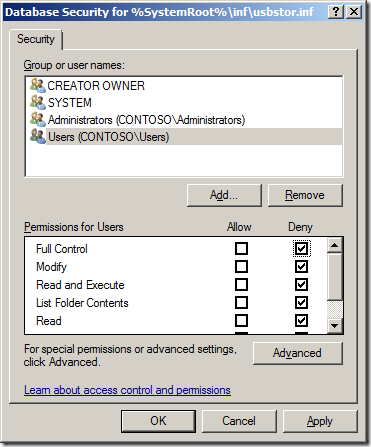Windows Vista Usbstor Registry
How to Fix Usbstor In Registry Errors Windows operating system misconfiguration is the main cause of Usbstor In Registry error codes Therefore, we strongly. Apr 07, 2011 Windows can’t find your USB devices? Make sure USBSTOR.INF is still there! Usbstor.inf usbstor.pnf All you. Windows XP, Vista and even Windows 7.

How to Fix Usbstor In Registry Errors Some plans, especially the ones which might be downloaded totally free from your Online, may have to have patches or bug fixes for them to work appropriately. Therefore, we Usbstor In Registry Repair Kit to fix Usbstor In Registry errors The following discussion features detailed instructions for fixing Usbstor In Registry errors in Windows system files. Both manual and automated techniques are described that are designed for novice and advanced users, respectively. The overview also provides basic troubleshooting procedures to follow in order to resolve typical causes of Usbstor In Registry error codes. What are Usbstor In Registry errors? A Usbstor In Registry error code is caused by a Hexadecimal formatting error. That format is the most common one that software programmers employ for Windows system files and Windows OS-compatible hardware drivers and software apps.
While in the Task Manager, it is possible to find out both of those the running apps as well as the qualifications procedures. Unix File Permissions Cheat Sheet. Manufacturers and developers of software apps and hardware drivers use different codes to indicate various types of errors. The Usbstor In Registry error message appears as a long numerical code along with a technical description of its cause. In many instances, a Usbstor In Registry error code could have multiple Usbstor In Registry parameters.
Each hexadecimal code denotes a different memory address location that loaded instructions when the error was generated. Additional messages associated with this matter: • Install Usbstor In Registry • Reinstall Usbstor In Registry • Usbstor In Registry crash • Usbstor In Registry is missing • Remove Usbstor In Registry • Download Usbstor In Registry • Usbstor In Registry virus How are Usbstor In Registry error codes caused?
Most Usbstor In Registry errors are due to a Windows operating system. RAM stands for Random Obtain Memory, and it’s the non permanent storage memory utilized by your pc. Rebooting fixes a great deal of difficulties in applications which could have stopped working fully. Numerous events may trigger system file errors. Most common examples include: 1) incomplete software installation; 2) incomplete software uninstallation; 3) improperly deleted hardware drivers, and 4) improperly deleted software applications. Also, Usbstor In Registry errors are very common during PC restarts that immediately follow a previous improper shutdown and recent virus or malware infection recovery.
Such incidents often result in the corruption or even total deletion of essential Windows system files. When system files are missing or corrupted, data that is essential to run software applications properly cannot be linked correctly. Specific causes and solutions for Usbstor In Registry errors • You will discover unique sorts of runtime problems such as runtime mistake 226 and runtime problems seven amid others.
• Reboot your PC. Global Limited Partners Directory Fourth Edition on this page. Insufficient memory errors are often resolved by merely rebooting the device. Try that simple task first to see if it fixes the error code problem. • Insufficient RAM. Verify that your system has enough RAM to run various software applications. System requirements are typically included inside the package that the program CDs came in or listed on the software manufacturer’s website under “Documentation” or a similar heading. • Memory mismanagement.
Many applications require installation of memory management programs. If your system already has a memory management application, uninstall it to see if that resolves the problem. • Insufficient disk space: Before installing any new software or driver, verify free space availability of at least 100 to 500 megabytes on your PC’s hard drive.
Any amount below that might prevent the swap file from expanding when required, due to inadequate free space. To check HD free space on Windows 95, 98, NT, 2000, ME, XP, Vista, and 7, open “My Computer” or “Computer.” Then, place your mouse cursor over the desired and right click. Next, left click “Properties” on the pop-up menu. A dialog will open that displays the amount of free space and total storage capacity. • Software program problems. If recurrent memory-related Usbstor In Registry errors occur when specific programs are executed, the software itself is likely at fault.